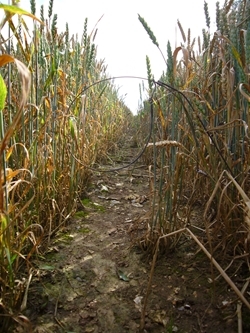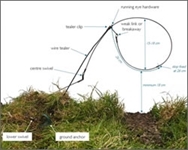Location
 In setting a snare, you are trying to outline with the cable the exact space in the landscape through which a fox’s head is going to pass. That’s a pretty extraordinary skill to acquire. Of course, sometimes a passing fox has its head down, and sometimes it has it up - you can’t accommodate all these chance variations. But you can choose places where foxes are likely to travel through quite fast, and conversely avoid places where foxes hesitate or loiter to sniff things. So if a run crosses a woodland edge or the edge of a thick hedge, don’t put your snare right at the edge: it’s here that the fox pauses to sniff or look about. Put the snare several yards back into the wood (avoiding clutter – see below), or if you are confident which way the trail goes, several yards out in the open.
In setting a snare, you are trying to outline with the cable the exact space in the landscape through which a fox’s head is going to pass. That’s a pretty extraordinary skill to acquire. Of course, sometimes a passing fox has its head down, and sometimes it has it up - you can’t accommodate all these chance variations. But you can choose places where foxes are likely to travel through quite fast, and conversely avoid places where foxes hesitate or loiter to sniff things. So if a run crosses a woodland edge or the edge of a thick hedge, don’t put your snare right at the edge: it’s here that the fox pauses to sniff or look about. Put the snare several yards back into the wood (avoiding clutter – see below), or if you are confident which way the trail goes, several yards out in the open.
Avoid snare sites cluttered by obstacles where there’s a strong risk of a captured animal getting the snare entangled. This often leads to considerable suffering and/or death. Alternatively, the snare swivels may become inoperative, leading to cable breakage and loss of the captured animal, often with the snare noose fixed around its body. Fences and gates carry a special risk of fatal entanglement and an increased risk of non-target captures. Do not set snares around the edges of release pens if there is a risk of entanglement occurring, for example with electric fencing equipment. In Scotland, the Snares (Scotland) Order 2010 made it an offence to set a snare in a place where a captured animal caught by the snare is likely to become fully or partially suspended, or drown. Beware therefore of setting of snares on, over or very near to watercourses, ditches, fences, scrub ‘clutter’, in forestry or on some steep banks.
The humaneness and non-target issues associated with entanglement are completely avoidable without loss of efficiency, because open sites are equally good or even better for catching – provided you have chosen and prepared your snares as described in this leaflet. Snares coloured as above and mounted on wire tealers will catch successfully even when set in open places without any vegetation cover. Foxes unthinkingly follow existing tracks if they offer easier walking. So try vehicle tracks even when they are just a pale stripe on the grass. You can even make your own track deliberately. If you have a fussy-footed dog that dislikes getting its feet wet or walking on stones (collies, whippets, and terriers are useful for this), watch where it trots: often it will indicate the nearly invisible route that foxes too will instinctively follow. Once you gain an appreciation of the kind of routes all foxes will instinctively take, there needn’t even be a run visible. We have caught foxes on a newly drilled field by judging where a fox would trot to go around a projecting bramble.
We try to leave the snare standing in a natural-looking arc, and we have the impression that the snares that best mimic a natural curve like a grass stem are the ones that are most likely to catch - but we have no objective measure of this.
Public access
Do not set snares close to a public right of way. Even though you check snares daily, there’s a chance that a member of the public will find a captured animal before you, or that their dog will get caught. Though you would be within your legal rights, there is no need to inflame public sensitivities like this and there will typically be plenty of locations where you are just as likely to snare a fox. In Scotland, given open access, the placement of snares relative to public use requires some careful judgement by the operator.
Near misses
If you have a near miss with a fox (snare knocked or drawn up, but fox fur left behind), don’t give up. Although the fox may have spotted the snare, you know you are on the right trail. Remove the snare and put a fresh, scent-free one two or three yards along the trail. This often results in a capture within a few days.
Expectations
Bear in mind that foxes do not walk every track every night. Give a new snare every chance to catch for a week or so. After that, begin to consider whether the snare might have been ‘spotted’ and should be reboiled and set in a new site.
When to snare
Every snare in operation will increase your chance of catching foxes, but it will also increase the risk of accidental capture of non-targets. For this reason we recommend you concentrate your use of snares to periods when gamebirds are vulnerable (eg. pheasant release time, wild bird nesting season) and when snaring will best contribute to your fox control effort (e.g. when vegetation cover prevents use of a rifle). From an efficiency point of view, we do not recommend using snares as semi-permanent devices because they are more efficient if regularly cleaned and reset (see above).
How many snares?
If you set snares when there isn’t a fox to catch, you will catch only non-targets. For this reason, we do not recommend that you use snares as your first means of detecting an incoming fox. Rather, we recommend you spend time looking for fresh fox signs (smell, tracks, fur, droppings, prey remains) and set snares where you find them. This strategy increases your chances of catching a fox quickly, reduces the amount of time spent checking otherwise ‘redundant’ snares and decreases the likelihood of catching non-targets. This approach requires intensive fieldwork, but will involve you in far fewer snare checks per fox caught. From our experience, on a lowland estate you may need only 20 snares and five nights per fox.
We recognise that many gamekeepers use snares as their first means of detecting an incoming fox. Sometimes you can’t find fresh fox sign, but experience tells you that there is bound to be one somewhere. This approach may be defensible where the risk of non-target captures is low, but in the majority of circumstances this is not the case. Experience will give you a ‘feel’ for good snare sites and you should concentrate on these. But again, don’t leave your snares there permanently - move them around, especially to locations where you detect fresh fox activity.
Get your FREE fox snaring guide from the GWCT team
Simply enter your email address below to download your essential free guide.
 What's inside your FREE fox snaring guide
What's inside your FREE fox snaring guide
✓ Fox control: Is it important?
✓ What are the alternatives to snaring?
✓ The main components of a well-designed snare
✓ Fox snares: Hardware vs practice
✓ Key controversies
Download free >